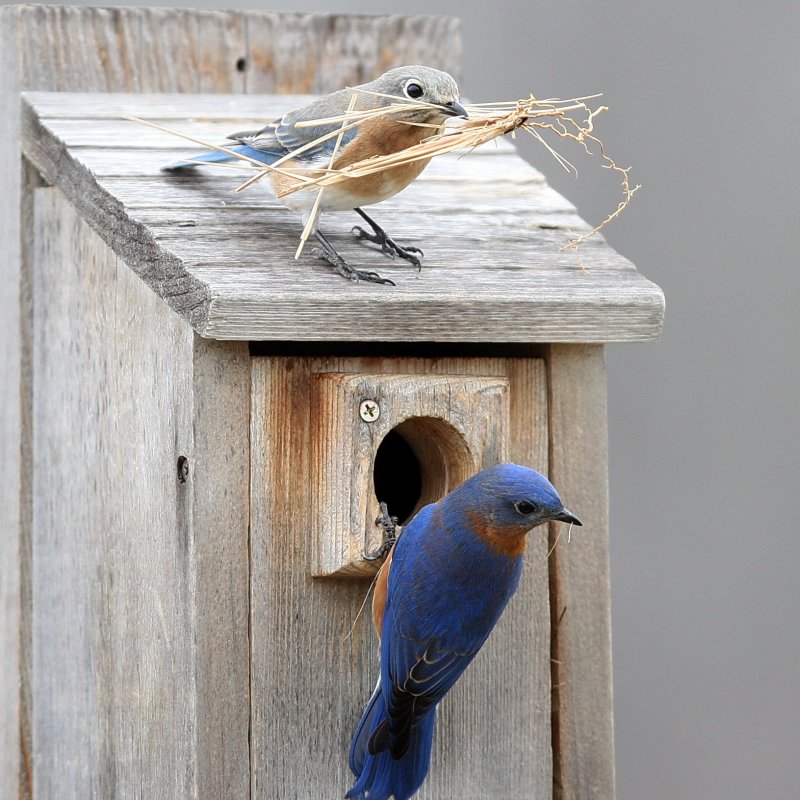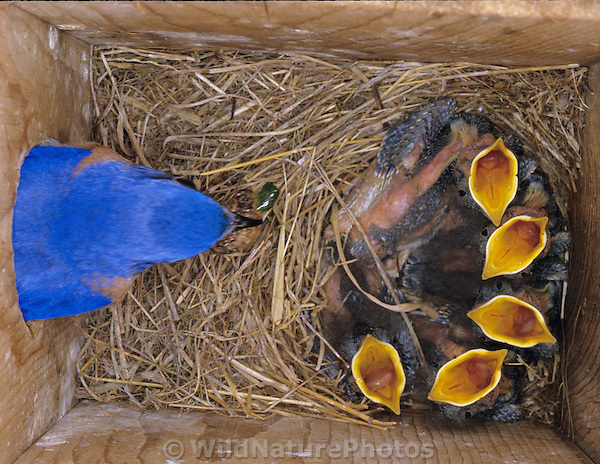Female & male bluebird building nest.
Female Eastern Bluebird.
The Wood Thrush Shop encourages people to be a little more involved during the period of time a bluebird, chickadee, or some other native bird, is raising their young in a provided nest box. Certainly, these birds are capable of doing all the important work themselves, but by monitoring you will be treated to a very interesting and amazing process. You may even be able to help them should a problem arise, like an ant infestation.
What is monitoring? Monitoring a nest box may include regular observation from nearby, and periodically opening the box, just enough to take a peek to see what phase of the process the nesting birds are in. Monitoring for me means doing a little of both.
Early Monitoring
· Look for signs of interest from birds. Regular daily appearances? Are they bringing nest material to the box, going in, or just perching on it for periods of time?
· Do you see competition for the nest box among different birds? You may see some territorial bouts, or some courtship behavior.
· Just observe a little each day.
Let’s jump ahead and say a pair of bluebirds has indeed chosen your nest box. Congratulations! Now how do you monitor?
· You’ve seen considerable activity by a pair of bluebirds at the nest box. When the Bluebirds are not present open the box and take a good look. What kind of nest material is being used? Bluebirds will most often use pine straw or fine dry grass. A nest may take hours or longer than a week to complete.
· Now you will be looking for that first egg. Bluebirds will typically lay between 3-6 eggs. When the nest appears to be complete it is recommended you begin looking in the nest box in the afternoons or evenings. Why? Because Bluebirds and other songbirds tend to lay eggs during early morning hours. You wouldn’t want to disrupt egg laying. Not that a bluebird would abandon the nest site because of one disruption but repeatedly could be cause. They will lay one egg per day until complete.
· Only after the female has laid the last egg will she begin incubating. Let’s say on the 4th day of monitoring the box you see a fourth egg. I would recommend you do not look on the 5th day in case 4 is where she stopped and is already incubating. Now is the time that I usually refrain from looking in the box unless I have witnessed her leaving the box temporarily to get some food and to stretch. Take note of how many eggs there are and their color. Bluebirds usually lay blue eggs, but sometimes they are white. I continue to observe from a distance, or a walk by close enough to be able to see something that might be of concern.
Bluebirds usually lay four to six eggs. They can range anywhere from off white to light blue to this bright turquoise.
Bluebird nests mainly consist of dried grasses. Dried pine needles are seen often too.
When you are certain the last egg was laid on a particular day, or the next, mark on your calendar, or smart phone, “14 days until hatching”. The female will incubate between 12 and 14 days at which point the babies will begin to hatch. Again, afternoons will be a better time to open the box to monitor. With cool nights and mornings the female will still be sitting with the chicks keeping them warm.
The Fledgling Period
For the next 15 to 18 days the baby bluebirds will be going through tremendous change. Again mark on your calendar the approximate day they will fledge from the box. Just 15-18 days after hatching! Daily brief looks in the box is fine. You may choose to look every two or three days.
Just hatched Bluebirds.
Starting to grow feathers. 5-7 days in.
Almost ready to fledge. 14-16 days in.
· You will see naked baby birds with eyes close during the first days. Near the end of the first week they will increase in size and begin developing their first feathers.
· By the 9th or tenth day they will be feathered but the feathers continue developing. By this time the babies will have more than three quarters of their final body weight. You may be able to determine the sex of the babies based on color of wing feathers. Those of the male will be bright blue, while females a pale gray-blue.
· At around the 12th or 13th day the babies are quite active in the nest and you may see signs of heads poking out of the entrance hole getting a look at the world. It is at this time we recommend not opening the box to look at them.They may be developed enough to leave the box if frightened.
· Keep observing from nearby and look for increased visits from the adults feeding young.
· In another couple of days babies will be ready to leave the box. Usually it takes a couple of hours for all the babies to finally leave where they will remain in a loose group, staying hidden in trees while the adults continue to tend to their feeding needs.
Congratulations, you have successfully monitored your Bluebird box. Now pull out the used nest material and be prepared for the next pair of birds to come along to begin nesting.







